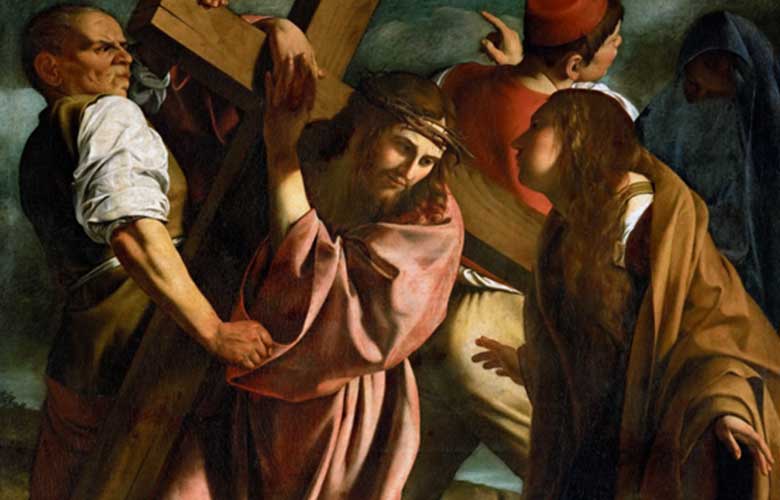The Paschal Mystery And Mary’s Role In Salation History
 April 29, 2019
April 29, 2019
Catholic theology is profound and balanced, because it acknowledges the significant and indispensable role played by the Blessed Virgin Mary in the history of salvation. This role began from the very moment she accepted God’s message through the Archangel Gabriel to be the Mother of Jesus, the Saviour of the human race. From that very moment until the Paschal Mystery of Jesus Christ, Mary has been part and parcel of all the events that eventually led to the salvation of mankind. Simply put, the Paschal Mystery refers to the Crucifixion, Death and Resurrection of Jesus Christ. These are the significant mysterious events that led to our salvation. For these events to be useful, they must be considered together as one composite event that brought about the salvation of the human race. The events that brought about our salvation usually culminate at Easter, the celebration of the resurrection of Jesus Christ. Easter Sunday for this Year 2017 was celebrated on April 16. Until Pentecost Sunday (June 4, 2017), the whole Catholic World continues to celebrate and reflect on the Paschal Mystery of Jesus Christ.
Furthermore, it must be noted that two, out of the twelve months of the year, are devoted to honouring the Blessed Virgin Mary. These two months of Mary are “May” and “October”. It is also worthy of note that this year 2017, the Catholic Church all over the world commemorates the Centenary of Marian Apparitions at Fatima in Portugal. In other words, this year, the Church is celebrating the one hundredth year of the several appearances of Mary to the three little shepherds—Lucy, Francisco and Jacinta—in a village called Fatima in Portugal in 1917. Hence, this month’s editorial reflection is devoted to the Blessed Virgin Mary for the aforementioned reasons.
Who is the Blessed Virgin Mary? The litany of the Blessed Virgin Mary gives a long list of how Mary could be described. It is actually a compendium of the titles of Mary. Generally speaking, Mary is the Mother of Jesus Christ, the Second Person of the Blessed Trinity. She is also the Mother of God. She is the Spiritual Mother of the Church. She is the Mother of all Christian faithful and, therefore, the Spiritual Mother of the Church. Other descriptions of Mary include Queen of Heaven (see Rev. 12:1); Queen of Apostles; Queen of Angels; Queen of Virgins; Queen of all the Saints; Queen of Nigeria; Queen of Peace; Our Advocate; Mary is the Mediatrix of all Graces; our Maternal Mediatrix; Mary is our Intercessor; our Helper; Mary is the “New Eve” because she is the “New Mother of all the living”. Mary is the first disciple of Jesus Christ. Mary is the first Tabernacle of Jesus Christ, because her womb was the first dwelling place of God the Son. Mary is the Mother of the Suffering Servant of God. She is our Lady of sorrows. Indeed, the list is inexhaustible! This is because our Mother Mary means different things to different people. We shall explain only four titles of Mary here, namely Mother of God, Mother of Jesus, Mother of all Christ’s faithful (i.e. mother of the Church) and Mary our Advocate and Intercessor.
Mary is the Mother of God. This is the first and foremost revealed truth about Mary from which all her other functions and honours flow. This doctrine holds and teaches that the Virgin Mary is the True Mother of Jesus Christ who is also God the Son made man (Mark Miravalle, 1993, Introduction to Mary, p. 34). The Archangel Gabriel’s message that comes from God Himself affirms that Mary is the true Mother of Jesus and, secondly, that Jesus is true Son of God. From these words of Gabriel, we can conclude that: Mary is Mother of Jesus; Jesus is God; therefore, Mary is Mother of God. Since Jesus is truly God the Son, and Mary is called “Mother of Jesus” in Scripture (see Mt. 2:13, 2:20; Jn. 2:1, 3; Acts 1:14, etc.) then Mary must be true Mother of God made man (Miravalle, p. 34; also John 1:1 and Phil. 2:6). With these scriptural backings, the Ecumenical Council of Ephesus in the year 431AD declared Mary as the Mother of God or in Greek Theotokos (which means “God-bearer”). The Council approved the teaching of St. Cyril of Alexandria who, against the errors of Nestorius, declared, “If anyone does not confess that Emmanuel (Christ) in truth is God and that on this account the Holy Virgin is the Mother of God (Theotokos) in as much as she gave birth to the Word of God made flesh…let him be anathema (Council of Ephesus, DS 113; Miravalle, p. 35).” At the Council of Ephesus, we see that authentic Marian doctrine will always protect and safeguard authentic doctrine about Jesus Christ.
The Blessed Virgin Mary is the Mother of Jesus, the Saviour of the world. The word “Jesus” is a name which means “Saviour”. That Mary would be the Mother of the Saviour of the world had been known even before creation. She had been chosen by God to be the Mother of Jesus before she was born. That was why she was preserved from the stain of Original Sin, theologically referred to as the Immaculate Conception. At the Annunciation, the Archangel Gabriel said to Mary, “You will become pregnant and give birth to a Son, and you will name him Jesus” (Lk. 1:31). Jesus means “Saviour”; Mary is the Mother of Jesus, our Saviour.
Spiritually, Mary is the Mother of all Christ’s faithful. This is related to the doctrine of the Mystical Body of Jesus preached by St. Paul. According to him, “Christ is the Head of the Body, and the Church is the Body of Christ” (Eph. 4:15; Col. 1:18). Mary, then, in conceiving Jesus, the Head of the Mystical Body, also conceived the faithful since we all are members of that same Body. In giving birth to Jesus the Head, Mary also gave birth to the Body, the Church, because the Head cannot be separated from the Body. Mary, in giving physical or biological birth to Jesus, made it possible for His members to receive spiritual life through Jesus. Hence, Mary is our true “Spiritual Mother”. It was because of this and other significant roles which Mary played in our salvation that Pope Paul VI proclaimed Mary as “Mother of the Church”.
Mary is our Advocate and Intercessor. An advocate is one who is called to intercede for another in need and particularly in court. It is an indispensable fact that, as our Loving Mother, Mary always intercedes for us. For instance, Mary performs her role as Advocate for the People of God at the Wedding at Cana (see Jn. 2:1-11). At the specific need of the hosts and people at the Wedding, the Blessed Virgin Mary, with great confidence, intercedes to the Lord for the people: “When the wine failed, the Mother of Jesus said to him, ‘They have no wine’….His Mother said to his servants, ‘Do whatever he tells you’” (Jn. 2:3, 5). Mary is the woman foreshadowed in Genesis who will fight the dragon-serpent in her mission with the Saviour Son (see Gen. 3:15; Rev. 12:3-7). As the child refers to the person of Jesus, so too, the woman who brought forth the child refers to the person of Mary (Rev. 12:5). The Early Church Fathers quickly acknowledged and confirmed Mary as Advocate, especially in God’s plan for our salvation. By the second century, St. Irenaeus referred to Mary’s advocacy to God for Eve, the first Mother of the living, who through disobedience was in need of the helping intercession of another: “…whereas Eve had disobeyed God, Mary was persuaded to obey God, that the Virgin Mary might become advocate of the Virgin Eve” (Miravalle, p. 62).
It must be acknowledged at this juncture that Mary’s positive response to the Archangel Gabriel’s message performed a significant foundational role that changed human history. Without it, there would be no salvation. It was her positive response that resulted to the conception of Jesus, the Saviour of the world. Thus, in explaining and describing who Mary is, we discover that all the functions which she has been performing right from salvation history are based on this positive response. This positive response is her role of obedience to God’s will, which is theologically referred to as her fiat: “Behold the handmaid of the Lord, be it done to me according to thy word” (Lk. 1:38). This particular fiat forms the foundation of all other functions or roles which the Blessed Virgin Mary carried out in her lifetime. This role is not just for the benefit of the Church alone, but for the benefit of the whole human race. Indeed, Mary’s fiat has changed the whole of human history. With Mary’s utterance of her fiat, the greatest miracle, the miracle of miracles, the mystery of the Incarnation of the Creator to the most perfect of all his creatures, became an accomplished fact.
The Second Vatican Council deliberated elaborately on the relationship between Mary and the Church, especially as regards salvation history. Precisely the eighth chapter of the document Lumen Gentium highlights the doctrinal synthesis and formulation of doctrine about the Blessed Virgin Mary within the context of the mystery of Christ and of the Church. By so doing, the Council, “stressed that the Mother of the Lord is not a peripheral figure in our faith and in the panorama of theology; rather, she, through her intimate participation in the history of salvation, in a certain way unites and mirrors within herself the central truths of the faith” (Lumen Gentium, no. 65).
After the Second Vatican Council, the encyclical Redemptoris Mater (Mother of the Redeemer) issued by Pope St. John Paul II, must be mentioned here. The entire Redemptoris Mater can be considered the encyclical of the “maternal and active presence” of Mary in the life of the Church (Redemptoris Mater, 1, 25), in the pilgrimage of faith, in the worship of the Lord, in the work of evangelization, in progressive configuration to Christ, and in ecumenical endeavour.
Mary is one who always seeks our salvation. If Mary is so good to us all, what should be our attitude towards her? Although some churches denigrate her by referring to her as an ordinary envelope, we Catholics continue to reciprocate her love for us by honouring her, especially through the daily recitation of the Holy Rosary, the Greatest Marian Prayer and the Best Family Prayer. Our Lady told St. Gertrude in a vision about how she would help those who recognize her dignity by honouring her, especially through the recitation of the Holy Rosary. She said, “I will truly prove myself a mother to all who devoutly recall to me the joy which I felt in uttering the words: ‘Behold the handmaid of the Lord’, and I will come to their aid without fail!” (see A. J. M. Mausolfe and J. K. Mausolfe, Saints Companions for Each Day, p. 103).
With his resurrection from the dead, the feast we celebrated few weeks ago, Jesus has proved that he is our Saviour de facto, and Mary was part and parcel of all it took for Jesus to win us our eternal salvation. Let us continue to honour the Blessed Virgin Mary, for being our true Spiritual Mother, who relentlessly desires the salvation of the whole world. Particularly in this month of May, I strongly recommend to all Catholic families, the daily recitation of the Holy Rosary, the Greatest Marian Prayer and the Best Family Prayer. This gesture shall certainly make the Blessed Virgin Mary to be happy with such devoted families; and she will readily and quickly come to their aid.
REV. FR. MARK AJIGA
 Guy Wilkins
Guy Wilkins Larry Reed
Larry Reed Roxanne Holland
Roxanne Holland Bridget Kennedy
Bridget Kennedy Sally Mendoza
Sally Mendoza